Cite this document
(The Innovation and Change of British Petroleum Research Paper - 1, n.d.)
The Innovation and Change of British Petroleum Research Paper - 1. Retrieved from https://studentshare.org/business/1750321-integrated-academic-report-the-innovation-and-change-of-bpbritish-petroleum
The Innovation and Change of British Petroleum Research Paper - 1. Retrieved from https://studentshare.org/business/1750321-integrated-academic-report-the-innovation-and-change-of-bpbritish-petroleum
(The Innovation and Change of British Petroleum Research Paper - 1)
The Innovation and Change of British Petroleum Research Paper - 1. https://studentshare.org/business/1750321-integrated-academic-report-the-innovation-and-change-of-bpbritish-petroleum.
The Innovation and Change of British Petroleum Research Paper - 1. https://studentshare.org/business/1750321-integrated-academic-report-the-innovation-and-change-of-bpbritish-petroleum.
“The Innovation and Change of British Petroleum Research Paper - 1”, n.d. https://studentshare.org/business/1750321-integrated-academic-report-the-innovation-and-change-of-bpbritish-petroleum.


